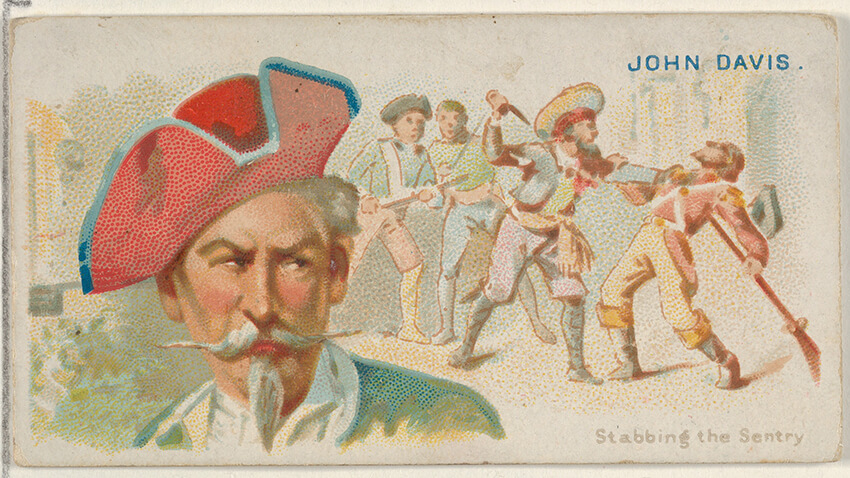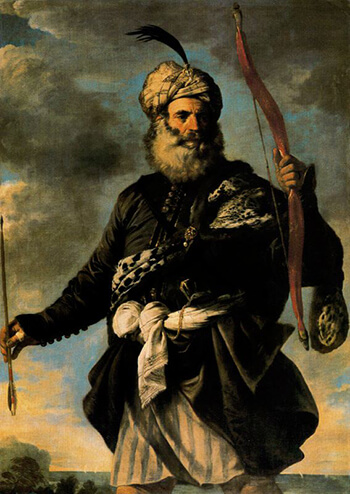Western Religions’ Influence on Piratical Endeavors During the Golden Age of Piracy
Along with flag, faith figured heavily in who was attacked, when, and where

For as long as the high seas have connected people and goods over great distances, the desire to plunder those connections has put trade and commerce at risk. Greed or necessity have motivated piracy, while politics have influenced the warfaring of privateering.
But another factor influenced the practice among the former soldiers and sailors of the colonial powers, especially in the Caribbean between the 16th and 18th centuries: religion.
Christianity
Christian Europe from the late-16th through the early-19th century saw a massive expansion of exploration and economic development and thus the growth of empires. With the religiously motivated expulsion of Muslims and Jews from Spain starting in 1492 and the development of Spanish trade routes in the 15th and 16th centuries, increased piracy across the Atlantic and Mediterranean followed. The European pirates preying on this trade hailed from many nations, so many forms of Christianity were represented.
From holy warriors to ocean-going bandits, religion was a significant factor in how pirates organized, who they attacked, and what motivated their efforts.
In some instances, religion was the direct motivation; in others it created the right environment for piracy to flourish. For example, the 16th- and 17th-century Catholic Spanish conflict with the Protestant Netherlands allowed Dutch pirates and privateers to use religious differences as rationale for their attacks on Spanish ships. Later, war between England and Spain opened a window for English letters of marque to be given in the Caribbean, including to pirates from Catholic nations. Letters of marque are licenses for military piracy; it was a legal way for private citizens to prey on enemy nations. It was also a way for countries with limited navies to fight powers with more ships.
There were also numerous instances of intrareligious piracy. Catholic French pirates attacked Catholic Spanish shipping and vice versa. The crusader spirit traversed religion, which nevertheless defined many of the parameters of piracy.
Malta
By the dawn of the great age of piracy in the 16th century, the holy wars of the Crusades had largely ended, though not necessarily for the Ottomans bottled into the eastern Mediterranean. As the powers of western Europe were on the rise, the vast Ottoman Empire was beginning its gradual decline; pressures to both keep what it had and to gain what it hadn’t fueled conflict. This was especially the case on the seas, where trade routes made or broke the economic powers of these states.
The Catholic Knights of Malta were originally founded as the Knights Hospitaller in Jerusalem in 1113. After centuries of war, first with the Arabs and then the Ottomans (who expelled the Knights from Rhodes), the Holy Roman Emperor Charles V gave to the order the island of Malta, part of a small archipelago between Sicily and north Africa; they then renamed themselves the Knights of St. John.
In his book The Pirate Wars, Peter Earle describes how they carried on a crusade well into the early modern age. The Knights would give letters of marque to ships of many other nations, in addition to their own galley-based attacks on Ottoman targets. The non-Maltese sailors engaged in piracy against the Ottomans, effectively expanding the Maltese fleet. These attacks earned the Knights the moniker of the Maltese corsairs.
Prior to the arrival of the Knights, piracy was already well established on Malta. Beginning in 870, after being annexed by the Abbasid Caliphate, the indigenous Maltese people began engaging in piracy against the Arab invaders. Their reputation as vicious pirates in the eastern Mediterranean grew from there. Like their Barbary counterparts, the Maltese corsairs preyed on ships for profit and were often backed by local investors. Letters of marque were also given out, both to civilians and Knights of the order.
The Maltese corsairs followed a strict religious code regarding their targets. Christian ships, except those that didn’t have a license from their respective Christian governments giving them safe passage, were protected against any attack by the Maltese, though Christian ships carrying goods from Muslim territories were considered acceptable targets, except those from France. English shipping, however, was always an acceptable target because the British crown was supplying weapons to the Barbary States (Morocco, Algiers, Tunis, and Tripoli). Furthermore, the Maltese were very strict in the enforcement of their rules.
As Paul Cassar details in his 1960 piece for The Catholic Historical Review, “The Maltese Corsairs and the Order of St. John of Jerusalem,” punishments for breaking their code ranged from fines to execution.
Protestants versus Catholics
The majority of piracy targeted Spanish trade, and many pirates came from Protestant countries; this punctuated the divide between Catholics and Protestants, whose conflict was in some ways worse than the one between Christian Europe and the Islamic world. An ongoing fear among the Spanish was the possibility of an alliance between either the English or Dutch and the Barbary corsairs, particularly an alliance between England and Morocco. This fear was founded on a past alliance between the Barbary corsairs and the French during the reign of Francis I.
Protestant-Catholic piracy was exacerbated by Protestant Dutch privateering and letters of marque during the revolution against Catholic Spanish rule in the Netherlands from the mid-16th through the early-17th century. These attacks were said to make the Spanish “sweat with a cold sweat,” as Violet Barbour describes in “Privateers and Pirates of the West Indies” from April 1911’s The American Historical Review.
During the late-16th and early-17th century, French Huguenot pirates put additional pressure on the Spanish, specifically in the French Protestant colony in Florida and from the ports of Dieppe and La Rochelle in the West Indies, the source of their raids. While politics motivated, often along religious lines, purely religiously inspired depredations were often invoked by pirates in the Atlantic world.

Consider the Searles raid on the Spanish colonial city of St. Augustine in 1668. The pirates were guided into the city and able to negotiate its defenses thanks to information from the former city surgeon, a Frenchman named Pedro Piques. Piques had been mistreated by the city governor because he was French, and he decided to turn over the information to the English pirates as revenge. The English took the city with relative ease. Among the items taken were the Catholic Church’s altar decorations, a detail that highlights the religious lines of the conflict.
Providence Island
In the early-17th century, English Puritans who migrated to Providence Island, off the east coast of present-day Nicaragua, engaged in piracy motivated largely by a desire to combat the flow of money to Spain. Like the French Huguenots in southern Florida, the founders of the Providence Island colony viewed attacks on Spanish commerce as an active means of protecting the future of Protestantism. For this they could not have selected a better location. With high rocky cliffs ringing the harbor and shoals surrounding the island, it was a natural fortress. The Puritans initially intended on simply being far enough away from England to avoid being tainted by the less reformationist court of King James I, but they soon discovered they were perfectly perched to attack Spanish vessels.
Islam

Like their Christian counterparts, many Muslim pirates saw their activities as part of a holy war. The influences of Islam on the activities and methods of the Barbary corsairs was more clearly pronounced than the influences of Christianity on the activities of most Christian pirates, the Maltese corsairs excluded. First, the rule against enslaving a fellow Muslim had a direct impact, upending the economics of Barbary piracy that relied on kidnapping and enslaving sailors for ransom and labor. Barbary targets were limited to only Christian shipping, a religiously defined limit not even the Maltese had. But like the Maltese corsairs, the Barbary pirates saw their actions as an extension of the wars that dated back to the First Crusade.
Unlike their Christian counterparts, the Barbary pirates would employ sailors outside their religion; they’d also work with non-Muslim states, such as the Algerian alliance with France. In “Barbary’s ‘Character’ in European Letters, 1514–1830: An Ideological Prelude to Colonization” (Dialectical Anthropology, 1982) Lotfi Ben Rejeb notes that European renegades — here in the original use of the word as one who reneges, in this case one who reneges on their faith — made up a large portion of Barbary pirate captains.
Barbary States
As part of the Ottoman Empire, the Barbary States had been engaging in piracy with the cover of being part of a more powerful entity. However, they gained greater independence, allowing them more freedom in the Mediterranean, after the Ottoman loss at the Battle of Lepanto, a 1571 naval engagement won by a coalition of Catholic Christian states. Barbary pirates were not limited to the Mediterranean.
Algiers had a station in the Cape Verde islands, allowing them to prey on Christian shipping in the Atlantic. Their method of kidnapping for ransom meant that they had three ways to make a profit off the venture, not including the value of the stolen goods: 1) ransom for the prisoners, 2) protection payments by the states they preyed on to prevent attacks, and 3) value from the work done by the slaves themselves.
The Barbary corsairs incorporated seafaring technology that gave the North Africans a major advantage in their taking of Christian ships, adding broad sail vessels to the galleys already used by the corsairs. While the Barbary corsairs themselves could have been easily defeated by a united European front, the political and religious divides among Europeans prevented such a response. The attitude taken by many Protestants was that working with Muslims was preferable to working with Catholics. In the 17th century some Protestants saw the Muslim Turks as “… better natur’d Christian … than the old Gentleman in Rome,” as an anonymous English playwright wrote in the 17th century.
Thus, not only did the Islamic faith fuel the Barbary pirates, but the schism between the Catholic and Protestant faiths created a political space for the Muslim pirates to flourish. Eventually, the politics changed in Europe, and the Barbary States were defeated after significant losses to the Americans, British, and finally the French in the 1815 Second Barbary War.
Judaism
While far fewer in number than either Christian or Muslim pirates, there are several historical cases of Jews engaging in piracy.
After being expelled from Spain and Portugal in 1492, some Jews joined the formerly Spanish Muslims who took to piracy. One noted example, recorded in an interesting English legal case and recounted by historian Lionel Abrahams, was Rabbi Samuel Palache, who was not only a distinguished member of the Jewish community of Amsterdam but also accused of piracy by the Spanish Ambassador to England. The court records show the Privy Council and several judges defending Palache quite vocally. The position of the Spanish Ambassador was that Palache had been involved in piracy targeting the Spanish Empire. Palache’s defense was that he had legal letters of marque from the King of Morocco.
Though Palache is the most noted Jewish pirate, given the Jews expelled from Spain, there were others. One such was Sinan, the lieutenant and right-hand man of Ottoman Admiral Barbarossa in the early-16th century.
Sinan had been accused of acts of piracy by the Spanish for sailing for the Turks. Though there is no documentation of how Jewish philosophy and theology influenced Palache or Sinan in their acts, the existence of Jewish pirates, especially those getting the attention from the Spanish royal court, is noteworthy. The majority of Jewish involvement in piracy was in the selling of stolen goods and exchange of prisoners.
Because Jews lived in both Barbary cities as well as Malta and in Christian Europe as well as Muslim Arabia and North Africa, they were a natural bridge between the Christian and Islamic worlds and would deal with business that required crossing from one religion’s realm to the other.
* * *
Religion contributed to several dynamics of Western world piracy from the late-16th century through the golden age of piracy, notably to how piratical endeavors were conducted and where and when they could happen. And the situations were not static; piracy flared at various times and in various places for evolving reasons; it was not a continuous and uninterrupted experience.
With religious wars and religious divides creating political space for piracy to occur, individuals motivated by faith were able to rationalize theft and violence. Like politics and economics, religion was inextricably linked to piracy.

